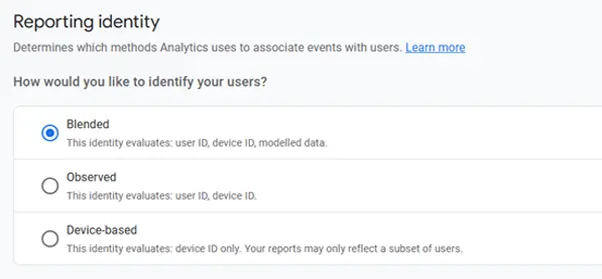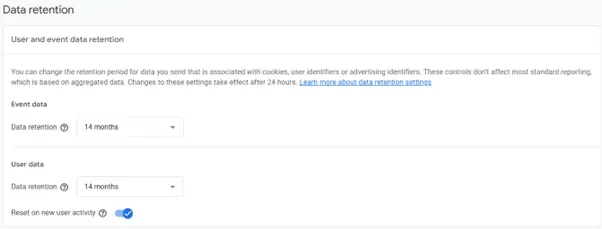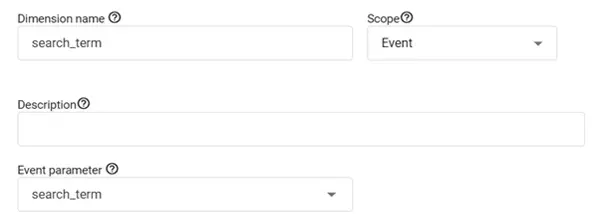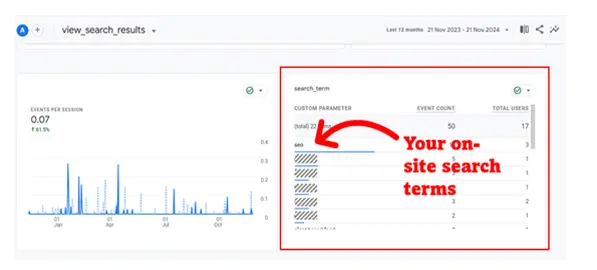Common GA4 Configuration Mistakes To Watch Out For
Ensuring data accuracy in Google Analytics 4 is a complicated process. After configuring and auditing many GA4 properties, we noticed that data inaccuracy is often aggravated by common configuration mistakes that can easily be avoided. In this article, we’ve listed the top configuration mistakes we find in GA4 properties, along with our advice on how to resolve them.

Using the Wrong Reporting Identity
TL;DR: To enable data modelling, if you have implemented advanced consent mode, ensure your property reporting identity is set to Blended. Please note that your GA4 property must also meet GA4’s prerequisites for data modelling to work.
If your website has on-site search functionality, you need to know what search terms your users are looking for.
The longer version:
If you’ve set up a consent banner on your website, data from users who reject analytics cookies won’t be reported in Google Analytics, leading to data gaps in your GA4 reports. However, if consent mode V2 is configured on your site, using the advanced implementation, and your GA4 property meets the data volume prerequisite to model the missing data, Google Analytics can estimate user data from users rejecting analytics cookies. This is called behavioural data modelling.
We are seeing a lot of businesses investing in the implementation of a cookie management solution integrating Consent Mode V2, with the goal of filling in the data gaps left by users rejecting cookies on the site. However, one aspect of the configuration to enable behavioural data modelling is often missed: the reporting identity selected in GA4.
Reporting identity in GA4 is used to identify users across devices and platforms and can use different techniques to identify users: User ID, Device ID, and Modelling.
To enable behaviour data modelling in your GA4 property, the reporting identity selected must include modelling, which is only available in the Blended reporting identity.
Using this reporting identity, GA4 will use the first user identification method available:
- User ID – this is based on unique identifiers generated by the site or app where GA4 is installed.
- Device ID – this is based on a unique identifier for each device accessing the site or app.
- Modelling – with this method, GA4 estimates user behaviour data based on data from similar users who did accept cookies.

Not Increasing the Default Data Retention Period
TL;DR: To enable long-term analysis and year-on-year comparison of user-level and event-level data in GA4, increase your data retention period from the default 2-month to 14 months.
The longer version:
If you are using the free version of GA4, when you create your property the default user-level and event-level data retention period is set to 2 months. This retention period applies to data associated with cookies, user identifiers (such as user ID) and advertising identifiers (such as DoubleClick cookies). User-level data relates to information associated with individual users identified through various identifiers such as cookies and user IDs. Event-level data includes interactions or events performed by the users across the website or app, which are tracked by Google Analytics.
For businesses needing to run long-term analysis and year-on-year comparisons, it is crucial to increase the data retention period to the longest option available in GA4: 14 months.
Please note that this data retention period applies only to user-level and event-level data. Aggregate data available in your out-of-the-box GA4 reports isn’t affected by this data retention period. Additionally, the 2-month retention period applies to users' age, gender, and interest data regardless of the retention period you select.
To maximise your data retention in GA4, we also recommend resetting the data retention period each time a user interacts with the site. This means you can keep user data for active users since their continued activity keeps their information in GA4. If users don’t visit your site or use your app before the retention period ends, then their data will be deleted.

Not Excluding Your Payment Gateway as a Referral Source of Traffic
Not excluding your site's payment gateway as a referral source in GA4 can cause significant issues in data accuracy and attribution analysis.
If the payment gateway isn't excluded, users returning to your site after completing payment can be counted as referrals from the payment gateway domain. This misattributes the conversion, as instead of crediting the original source (e.g., Google Ads, organic search, or email), GA4 attributes the conversion to the payment gateway domain (e.g., paypal.com, stripe.com), which is reported under referral traffic.
To verify whether your payment gateway has attributed conversions under Referral, go to your Traffic Acquisition report and filter by Referral Traffic and add a secondary dimension for Source.
If your payment gateway is being recorded as a referral traffic source, it will appear in the list of sites sending traffic to your site.
You can also verify the number of conversions and revenue attributed, if you have ecommerce tracking set up.
How to Exclude Your Payment Gateway as a Referral Source:
- Go to your Data Stream settings in the Admin area.
- Access your Google Tag Settings and find the List Unwanted Referrals section.
- Add your payment gateway domain as an unwanted referral.
This will instruct GA4 to exclude your payment gateway from the list of sites considered as referrals and force GA4 to attribute future conversions to their actual sources.
Not Setting Up a Custom Dimension for Search Terms
If your website has on-site search functionality, you need to know what search terms your users are looking for. This information provides invaluable insights into your visitors’ needs and can help you spot gaps in your content or product offering or identify if your navigation isn’t enabling users to easily find what they’re looking for.
GA4 enables you to track on-site searches via the Site Search Enhanced Measurement event, which can be activated in your data stream settings. However, configuring a custom dimension is also required to report on the terms searched by your users in GA4.
Steps to Configure the Search Term Custom Dimension:
- Go to the Admin section of your GA4 property.
- Under Custom Definitions, create a custom dimension called
search_term, with the event parameter also beingsearch_term.

Once this is configured, search terms will be recorded, and you can view them in the Events report for the view_search_results event. A new search_term card will appear in your event dashboard, enabling you to analyse what users are searching for.

Get in Touch
If you’re getting started with GA4 and need help understanding how the platform works, or you are concerned about the accuracy of your data in Google Analytics, or if you want to configure your GA4 tracking according to your specific business needs, our team of analytics experts can help. Get in touch today to find out about our GA4 set up and auditing services and how we can help you take control of your data so you can feel confident using GA4.

